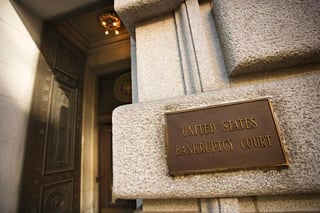 Last week, I wrote about the historical origins of the bankruptcy law - that the concept of a structured program of debt forgiveness was as old as Moses, and that Julius Caesar had formulated the first bankruptcy law that contained features that continue to this day. At the end of last week’s blog, I referred to Article I, Section 8 of the Constitution, that gave the United States Congress the sole authority to make “uniform” bankruptcy law. This week I’ll look at the historical development of bankruptcy law in the United States, from the time of our nation’s founding, to the present.
Last week, I wrote about the historical origins of the bankruptcy law - that the concept of a structured program of debt forgiveness was as old as Moses, and that Julius Caesar had formulated the first bankruptcy law that contained features that continue to this day. At the end of last week’s blog, I referred to Article I, Section 8 of the Constitution, that gave the United States Congress the sole authority to make “uniform” bankruptcy law. This week I’ll look at the historical development of bankruptcy law in the United States, from the time of our nation’s founding, to the present.
The First Bankruptcy Law
While the Constitution provided for Congress to make bankruptcy laws, it was more than ten years after the Constitution was ratified in 1789 before Congress passed a law regarding bankruptcy in the United States. The Bankruptcy Act of 1800 was the first bankruptcy law that was passed by Congress. And although other countries had found that given defaulting debtors a certain amount of leniency was financially wise for society as a whole, the Bankruptcy Act of 1800 was dedicated to the protection of creditors, not debtors. The 1800 law was limited in scope - it only contemplated involuntary bankruptcy against merchant debtors. That is, a debtor could not file a bankruptcy case to protect himself from creditors; under the 1800 law, only creditors could force a debtor into bankruptcy, and the debtor had to be engaged in business.
Under the 1800 law, once a creditor or creditors had forced a debtor into bankruptcy a judge of United States District Court was assigned to the case and a third party, called an assignee would take over the debtor’s property and sell the property to pay creditors. The assignee was chosen by the creditors. The assignee in the 1800 law is the ancestor of today’s bankruptcy trustee.
The law was passed to meet a need: for a decade there had been an increase in business failures, prompting Congress to act. But the law didn’t work the way the drafters envisioned; there was ample opportunity for corruption by both debtors and creditors. Malicious creditors could force an otherwise viable business out of business through the use of the law, and debtors would identify “friendly” creditors with whom they would work to discharge other commercial debt they had. When Congress passed the 1800 law, a provision in the law had an automatic repeal scheduled for 1806, but Congress acted to repeal the law early, in 1803.
The 1841 Law
Congress did not pass another bankruptcy law until 1841, when it passed the Bankruptcy Act of 1841. This law was passed in response to the financial panic of 1837, and for the first time, the law allowed debtors, both merchants and non-merchants, to file a voluntary bankruptcy to protect themselves from creditors. The confusion in this law had to do with what court would handle disputes between creditors and bankruptcy debtors - United States District Court or a State Court. The Supreme Court decided in 1845 that the United States District Court should have exclusive jurisdiction over bankruptcy cases, thus removing, once and for all, bankruptcy litigation from state court forums.
The 1841 law provided for the concept of the bankruptcy discharge - the elimination of debt owed by debtors to creditors at the completion of the bankruptcy process.
The 1841 law also incorporated features that remain with us today with respect to the recovery by the bankruptcy estate of preferential payments to creditors and fraudulent transfers of property by debtors to friends or relatives.
Another feature of the 1841 law was the prohibition of debtors using state law to protect their property. Rather, debtors were required to use the exemptions provided for in the federal law to protect assets.
The law was quite sympathetic to debtors, and in a short period of time over 33,000 bankruptcy cases were filed. The benefit provided to debtors proved unpopular with the general public, though, and as a result, the 1841 law, like the 1800 law, was repealed by Congress.
The 1867 Law
It took until 1867, the negative economic impacts of the Civil War and a post-war financial panic before Congress passed another bankruptcy law. The 1867 law broke new ground as the statute began to evolve into something that we recognize today. There were several innovations in the 1867 law. The 1867 law definitively identified the United States District Court as the court of original jurisdiction in bankruptcy matters, eliminating all question about court jurisdiction (the 1800 and 1841 laws were silent; it took a Supreme Court decision interpreting the 1841 law to suggest that the Federal Court was the court with bankruptcy jurisdiction).
The 1867 law also provided for something called “composition agreements,” a procedure for debtors to negotiate repayment terms with creditors, including the ability to negotiate settlement at less than payment in full on defaulted accounts. Composition agreements foreshadowed the chapter 13 and chapter 12 bankruptcies we have today.
The law also provided that district court judges could appoint “bankruptcy registers” to handle bankruptcy cases - the registers performed some duties of today’s bankruptcy judges.
The law required creditor approval in order for a bankruptcy debtor to receive a discharge of debt, or required that the creditors receive at least 60% of the debt owed.
Very importantly, for the first time the law allowed debtors to select protection of property either by using state law, or by using exemptions provided for in the federal statute.
Additional features of the 1867 law was for the first time both individuals and merchants could be put in an involuntary bankruptcy by their creditors and corporations were, for the first time, included in the scope of bankruptcy law, although corporations were not allowed to file a voluntary bankruptcy case.
In 1874 the bankruptcy law was amended to allow debtors to propose to distribute assets among creditors as a way of settling claims.
While the 1867 law further developed the substantive law and procedure of bankruptcy, there were still problems with abuse of the process and excessive fees. As a result, Congress repealed the 1867 law in 1878. It would be another 20 years before Congress passed another bankruptcy law. But when Congress acted again, in 1898, it created a law that survived for 80 years. We’ll look at the 1898 law, and the 20th Century adjustments to that law, next week.


